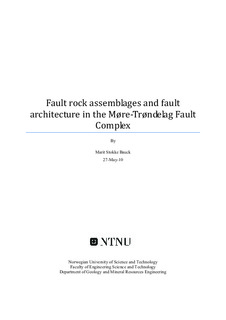Fault rock assemblages and fault architecture in the Møre-Trøndelag fault complex
Abstract
The Møre-Trøndelag Fault Complex (MTFC) is a major fault zone, extending along the coast of mid-Norway. It has a prolonged history of reactivation. Three outcrops along parts of the MTFC, known as the Tjellefonna Fault have been described in this study. The focus has been the study of fault architecture and the related fault rocks.
At Vik, more than three sets of fault lenses have developed, bounded by numerous faults in a complex pattern. The faults here are cutting the foliation at a high angle, resulting in the complex fault architecture. For the other localities of Rød and Mulvik, the faults are partly reactivating the Caledonian foliation, making the fault architecture more regular and systematic.
All fault rocks sampled in this study are brittle, and are suggested to have formed at crustal depths of 9 km and shallower. The matrix of the fault rocks is dominated by elongated laths of zeolite. These are torn off from the crystals along the cleavage. At least 3 generations of zeoliteare found at Vik and Mulvik. The first generation pre-dates a zeolite-dominated cataclasite. At Mulvik this was followed by another generation of zeolite, two generations of cohesive breccia and a third zeolite generation. One of the last generations are found to be steep sets of extensional fractures filled with zeolite. This zeolite is analysed by XRD and found to be laumontite.
The last activity of faulting is thought to be represented by the uncohesive breccia found at Mulvik. This is related to shears, interpreted as R-shears indicating an overall “northwest sidedown” sense of movement of this last activity along the fault.
